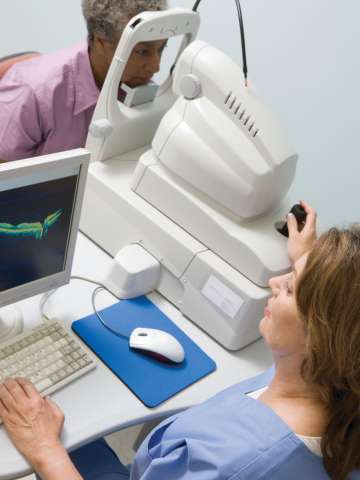Glaucoma Care & Treatment
We offer comprehensive, personalized glaucoma care from leading glaucoma specialists. Our physicians use a variety of advanced, state-of-the-art glaucoma treatments.


Why choose UCLA Health for Glaucoma Care & Treatment?
Our glaucoma specialists provide comprehensive, personalized care. The glaucoma program at UCLA Health is part of the UCLA Stein Eye and Doheny Eye Institutes. Our program consistently ranks among the best in the nation in ophthalmology by U.S. News & World Report. Patients who come to us receive treatment from a team with a national reputation for excellence and leadership in glaucoma care and research.
Highlights of our program include:
Expert physicians: Our faculty are nationally renowned leaders in the medical community. We have published hundreds of articles, authored books and regularly give lectures in the U.S. and abroad. Many of our physicians hold positions in ophthalmic professional societies, including the American Glaucoma Society and Glaucoma Research Society, an international organization in which election is required for membership. One of our physicians is the former president of the American Academy of Ophthalmology.
Treatment for complex needs: We receive referrals for many complicated cases, including pediatric glaucoma cases. Physicians across the country send their patients to us for our expertise.
Care coordination: We make patient visits a one-stop shop as much as possible, so you see all the necessary specialists in one trip. Physicians also offer telemedicine visits to increase access to care. All our physicians also treat cataracts, leading to seamless care coordination for patients with concurrent diseases.
Our Glaucoma Services
Our glaucoma physicians diagnose and treat patients in several clinic locations throughout Southern California offering full glaucoma treatment and glaucoma surgery capabilities. Additional services include:
Glaucoma Advanced Imaging Laboratory
The mission of our imaging laboratory is to improve and optimize imaging techniques that detect glaucoma or other eye diseases that cause vision deterioration. This laboratory is funded by the National Institutes of Health (NIH) to enroll patients with and without advanced glaucoma damage. Our goal is to optimize and develop methods to detect glaucoma progression in a timely manner.
To learn more about the laboratory, call 310-794-1487.
What is Glaucoma: Understanding Glaucoma Diagnosis & Treatment
Glaucoma is a term for a group of conditions that involve damage to the optic nerve often requiring long-term glaucoma treatment, leading to vision loss and eventual blindness. The optic nerve carries messages from your eyes to your brain to help you see. Many forms of glaucoma are characterized by increased pressure in the eye (intraocular pressure) or improper fluid drainage in the eye, leading to optic nerve damage.
There are two main types of glaucoma and a number of associated sub-types:
Primary glaucoma: This type of glaucoma is not caused by another medical condition. Sub-types include:
- Open-angle glaucoma: Primary open-angle glaucoma (POAG) is the most common of all glaucoma types, affecting nine in 10 glaucoma patients in the United States. Experts think open-angle glaucoma develops when the eye doesn’t drain fluid fast enough, creating pressure on the optic nerve.
- Normal-tension glaucoma: This type develops when the optic nerve is damaged but eye pressure remains normal. Experts don’t know exactly what causes it, but there are some risk factors for the condition, including family history, heart problems, low blood pressure or being of Japanese descent. Other names include low-tension or normal-pressure glaucoma.
- Angle-closure glaucoma: Also called narrow-angle glaucoma, this condition is a medical emergency that causes intense eye pain, red eyes, blurred vision and nausea. It occurs when the colored part of the eye (iris) blocks fluid drainage, causing rapid pressure buildup. If left untreated, this glaucoma type can cause blindness in only a few days.
- Congenital glaucoma: About one in 10,000 babies is born with eye problems that prevent proper drainage. Early symptoms include cloudiness in the eyes, extra tearing, irregularly large eyes or sensitivity to light. Babies who receive early treatment usually don’t experience permanent vision loss.
Secondary glaucoma: This type of glaucoma is caused by another medical condition. It may occur as open-angle or angle-closure glaucoma. Sub-types include:
- Neovascular glaucoma: This type develops when the eye makes blood vessels that cover the portion of the eye where fluid should drain. It most commonly occurs due to diabetes or high blood pressure.
- Pigmentary glaucoma: In this type, the colored flecks from the iris flake off and block areas of normal fluid drainage. Young, near-sighted white men are most likely to develop this type.
- Exfoliative glaucoma: Also called pseudoexfoliative glaucoma, this type develops in people who have exfoliation syndrome, a condition that causes extra debris to gather on the eye. The debris blocks fluid drainage, eventually leading to pressure buildup on the optic nerve.
- Uveitic glaucoma: People who have uveitis, an eye condition that causes inflammation, may develop this type of glaucoma. Inflammation and scar tissue may block the area of the eye where fluid should drain.
Some patients also have glaucoma that develops because of cataracts, tumors or eye injuries. Our specialists have the expertise to effectively treat all types of glaucoma, including complex glaucoma surgery cases.
Tests and Procedures Glaucoma Specialists Offer
Our specialists diagnose and treat all types of glaucoma, including complex or advanced cases. We use state-of-the-art diagnostic tests and treatment techniques.
Glaucoma diagnosis
Glaucoma specialists offer a range of advanced tools to diagnose glaucoma and guide glaucoma treatment options. We may use a series of imaging scans and tests that:
- Assess vision loss, including peripheral (side) vision
- Evaluate the optic nerve fibers
- Look for optic nerve damage
- Photograph the optic nerve at specific points in time
- View the angle between your cornea, the transparent outer covering of your eye, and the iris, the colored tissue in the center of your eye that contains the pupil
Glaucoma treatments & surgery options
We provide advanced, effective glaucoma treatment, including:
Topical medications: Medicines such as eye drops may reduce pressure in the eye or decrease the amount of fluid your eye makes. For many patients, eye drops can control glaucoma symptoms for years.
Laser treatments: Physicians offer in-office laser treatments for glaucoma as part of nonsurgical glaucoma treatment. These therapies can help the eyes drain fluid more effectively, reducing eye pressure. Our specialists use advanced laser techniques and technologies, including argon, N-YAG and pulsed-dye laser therapy.
- Trabeculoplasty: The surgeon uses a slit lamp microscope and lens to direct a laser to the eye’s natural drainage system (trabecular meshwork). This procedure treats primary open-angle glaucoma by lowering eye pressure.
- Iridotomy: The surgeon uses a slit lamp microscope to focus the laser on the iris, the colored part of the eye. They create a small hole in the iris to restore fluid flow and relieve pressure. This procedure treats angle-closure glaucoma.
Glaucoma filtration surgery (trabeculectomy): The glaucoma surgeon creates a small flap in eye tissue with a new drain underneath it to reduce eye pressure. The surgeon sews the flap back down and covers the area with the conjunctiva, the outer layer of the eye. The procedure creates a small fluid-filled blister, a bleb, underneath the eyelid. The fluid inside the blister gets reabsorbed into the body and the bleb is typically not noticeable to others.
Glaucoma drainage implant surgery: We place a small drainage tube in the eye. The tube creates a new channel for the eye to drain fluid, reducing intraocular pressure. Surgeons cover the tube with a small patch, which patients typically can’t see or feel after the procedure.
Combined surgery for glaucoma and cataracts: Our specialists may offer combined surgeries for patients with glaucoma and cataracts . This approach may be more convenient and efficient for patients, reducing the need for multiple surgeries and office visits.
Our Expert Glaucoma Team
The glaucoma physicians at UCLA Health have advanced, specialized training in glaucoma diagnosis and treatment, including glaucoma surgery expertise. As nationally established leaders in glaucoma research and treatment, our experts have published studies, authored books and delivered presentations at numerous ophthalmology conferences.
Faculty & Staff
Optometry
Support Glaucoma Research
Glaucoma damages the optic nerve, resulting in vision loss and, in some cases, blindness. Vision loss from glaucoma can be slowed or prevented by early detection and appropriate, individualized treatment. Physician-scientists in the Glaucoma Division at UCLA Stein Eye Institute seek to identify individuals at greatest risk for vision loss, develop personalized strategies for their care, and implement new therapies to preserve their vision.
Clinical research: Division scientists are developing better methods to measure rates of glaucoma damage and identify patients at high risk of blindness. These efforts help develop and implement effective, individualized therapies.
Translational research: We convert laboratory findings into medical practice, moving information from promising experiments through clinical trials to point-of-care patient applications. Division members are actively involved in developing new and improved treatment strategies and innovative clinical trials.
Glaucoma Division Team Members
Stein Eye Glaucoma Division Faculty have:
- Demonstrated that nerve cells damaged by glaucoma can be rescued and robust treatment can reverse glaucoma-related visual damage.
- Developed techniques to identify patients at highest risk for vision loss. Implemented artificial intelligence approaches to predict which patients are at high risk of disease deterioration.
- Identified which social determinants of health are increasing the likelihood of the progression of vision loss in glaucoma patients.
- Developed new surgical techniques for the management of glaucoma and its complications.
What new treatment will you fund?
Using newer statistical methods to estimate how fast glaucoma is deteriorating in an individual patient so that timely action can be taken and change the way we monitor glaucoma.
Applying AI to analyze previously gathered glaucoma data, including numbers, images, photographs, etc., to predict the future course of the disease and proactively use therapies to slow disease progression.
Using clinical and genomic data collected by UCLA’s ATLAS program to enhance our understanding of the genetic determinant of health and disease related to glaucoma. ATLAS intends to enroll a diverse patient population of 150,000 or more patients into the UCLA Precision Health Biobank. Genetic information gathered will be integrated with de-identified clinical information from the patient medical records for predictive modeling.
Your donations are what make these innovations in glaucoma treatment and therapies possible.
To learn how you can support glaucoma research to stop vision loss with a donation, please ask your doctor, a staff member, or contact:
Susan Lee DeRemer, CFRE
Director of Development
UCLA Stein Eye Institute
310-825-3381 or [email protected]
uclahealth.org/eye/glaucoma-division
Contact us
Call 310-794-9442 to request an appointment with a glaucoma specialist for glaucoma treatment or glaucoma surgery at UCLA Health.

To make a donation to the Glaucoma Research Fund, please scan the QR code.
Please review UCLA and The UCLA Foundation’s QR Disclosure Statements for Prospective Donors and learn CODE more about how The UCLA Foundation invests and manages its endowments at www.uclafoundation.org/Resources/Disclosures.
Find your care
Our glaucoma specialists are highly trained, established experts. Call 310-794-9442 for more information about our glaucoma services.












